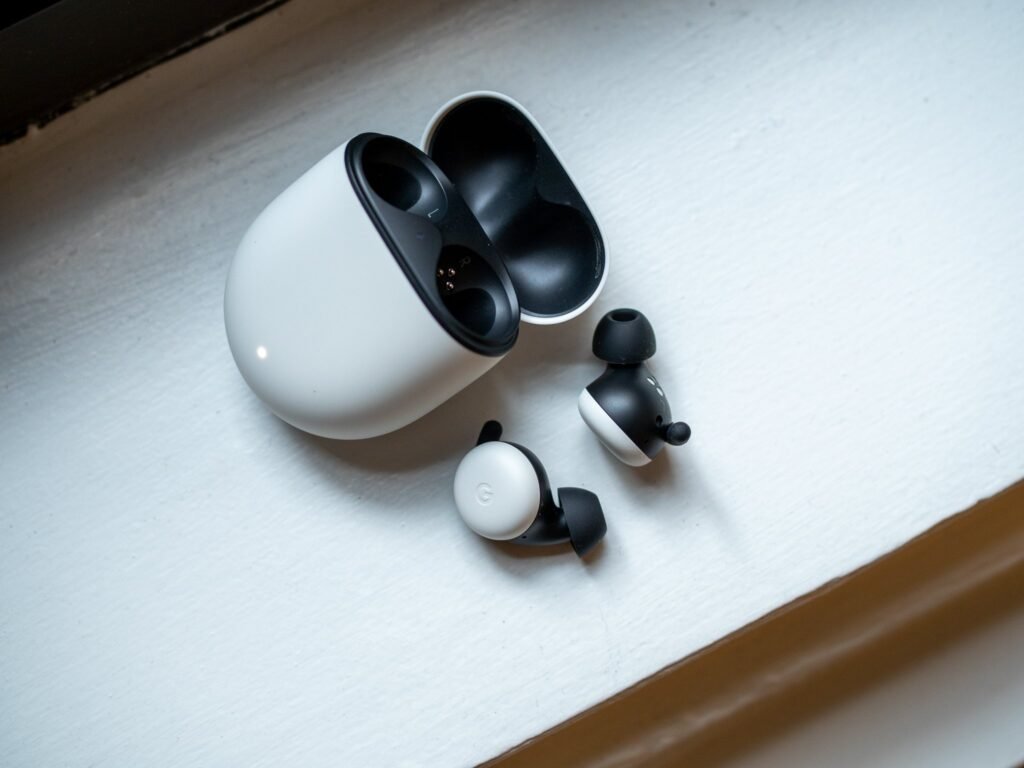Three years after their ambitious but awkward neckband debut, Google returned to the audio space in April 2020 with the second-generation Google Pixel Buds. This was a complete redesign and a true wireless reboot, aiming to deliver on the original’s promise of smarts and helpfulness in a sleek, modern, and comfortable package. With a premium design, excellent sound, and deep Assistant integration, they were poised for success, but a persistent technical flaw ultimately defined their legacy.
A Masterclass in Design, Comfort, and Fit

Google jettisoned the old neck-cord design entirely, creating a pair of earbuds and a case that were widely praised for their thoughtful ergonomics and aesthetic appeal.
- True Wireless Form Factor: The new Pixel Buds were two separate, discreet earbuds. Their design was often compared to a Mentos candy – a small, round, matte-finish disc that sat flush and unobtrusively in the ear.
- Secure Fit System: To ensure a stable fit, Google combined two elements. First, replaceable silicone ear tips (in three sizes) provided a good seal for passive noise isolation. Second, an integrated, non-removable soft-touch “stabilizer arc” (a small fin) tucked comfortably into the upper part of the ear, locking the buds in place. For most users, this resulted in an incredibly secure and comfortable fit, suitable for running and workouts.
- Spatial Vent: A key comfort feature was the “spatial vent,” a tiny physical opening in the earbud. This was designed to relieve the feeling of in-ear pressure or “plugginess” that can come from sealed earbuds, while also allowing the user to maintain a subtle awareness of their surroundings.
- The Iconic Case: The charging case was a design triumph. A smooth, matte-white, egg-shaped pod that felt wonderful in the hand, it featured a satisfying magnetic closure and a soft-touch interior. It was compact, pocketable, and supported both wired charging via USB-C and wireless charging via any Qi-certified pad.
- Durability and Colors: The earbuds had an IPX4 rating, making them resistant to sweat and light rain. While initially launching in “Clearly White,” they were later released in “Oh So Orange,” “Quite Mint,” and “Almost Black.”
Enhanced Audio and Smarter Features
The 2020 Pixel Buds were a significant step up in sound quality and intelligence.
- Rich Audio: Custom-designed 12mm dynamic drivers delivered a full, rich, and detailed sound profile that was a dramatic improvement over the first generation. The audio was well-balanced, making it enjoyable for music, podcasts, and calls.
- Adaptive Sound: This clever feature automatically and subtly adjusted the volume in real-time based on the noise levels of your environment. As you moved from a quiet room to a noisy street, the volume would gently increase, then decrease again when you returned to a quiet space.
- Hands-Free Google Assistant: The integration with Google Assistant was best-in-class. Without touching a button, users could simply say “Hey Google” to send texts, get directions, control music playback, ask questions, and hear their notifications read aloud. The live translation feature also returned, functioning more smoothly through the updated Assistant interface on a paired Android phone.
- Intuitive Controls: Both earbuds featured reliable touch controls. Taps handled play/pause and call management, while intuitive forward and backward swipes controlled the volume – a premium feature many competitors lacked at the time.
The Achilles’ Heel: Connectivity
Despite excelling in design, comfort, and smarts, the 2020 Pixel Buds were plagued by a single, critical flaw: unreliable Bluetooth connectivity.
Widespread reports from users and reviewers highlighted frequent and frustrating issues, including:
- Random audio dropouts, often lasting for a second or two.
- One earbud (frequently the left) losing connection entirely, requiring it to be placed back in the case to reset.
- These issues were particularly pronounced when outdoors, where there were fewer surfaces for the Bluetooth signal to bounce off.
Google released several firmware updates attempting to fix these connection stability problems, but for a large number of users, the issues were never fully resolved. This fundamental unreliability undermined the otherwise excellent experience, making it difficult to recommend the product without a major caveat.
Battery Life
The Pixel Buds offered standard battery life for the era.
- Listening Time: Up to 5 hours of continuous listening on a single charge.
- Total Time: The wireless charging case held additional power for a total of up to 24 hours of listening time.
- Fast Charge: A quick 10-minute charge in the case provided up to 2 hours of listening time.
Reception and Legacy: So Close to Greatness
The 2020 Google Pixel Buds are remembered as a product that was nearly perfect but was ultimately let down by its most crucial function. They received immense praise for their brilliant industrial design, exceptionally comfortable and secure fit, high-quality sound, and unmatched smart features.
However, almost every positive review came with a significant “but” regarding the persistent connectivity dropouts. This fatal flaw made them a frustrating gamble for consumers. Their legacy is twofold: they established the iconic design and feature set that would define the Pixel Buds line, but they also served as a hard-learned lesson for Google. The widespread connectivity issues directly led to a focus on reliability for their next model, the highly successful Pixel Buds A-Series, which would retain the beloved design while finally delivering the stable connection users demanded. Of course. After the ambitious but flawed 2017 original, Google took three years to completely rethink its approach to personal audio. The result, launched in April 2020, was a true wireless reboot that got so much right, but was ultimately hampered by a critical weakness.
